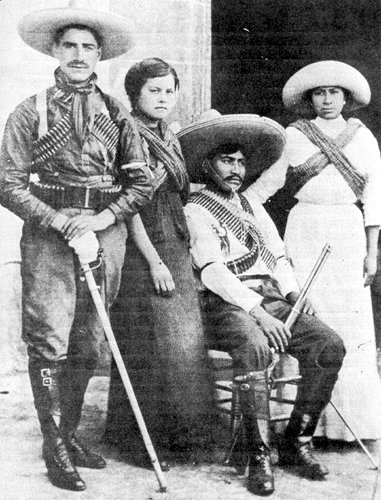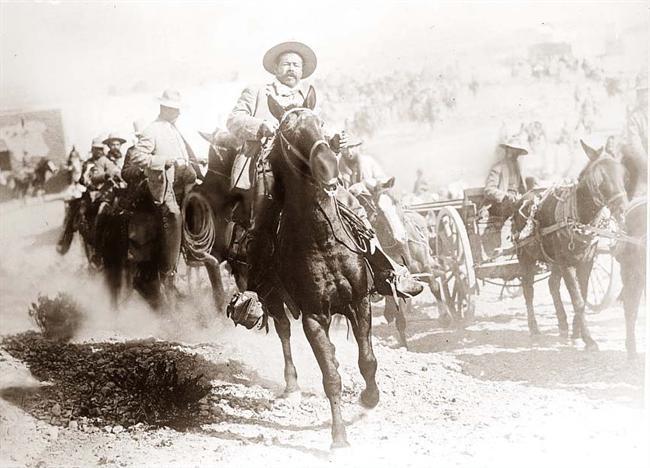HISTORY 361:
The Mexican Revolution: Birth, Life, Death
Fall 2008
|
Mr. Volk
Classroom: Mudd 052 (Tuesday 7:00-9:00 PM)
Office: Rice 309; Phone: x5-8522
Email: Steven.Volk@oberlin.edu
Office Hours: Tues 11-Noon; Wed 1:30-2:30; Thurs 3:30-4:30, and by appointment
|
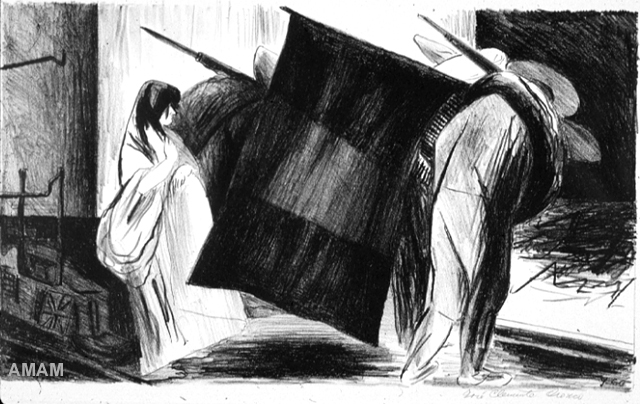
José Clemente Orozco,
"The Flag" (1928) - Allen Memorial Art Museum (Oberlin, OH)
|
The Mexican Revolution is one of
a handful of monumental social, political and cultural movements which shaped
the 20th century landscape. As such, not only has it generated a massive amount
of historical writing, but it has also strongly influenced cinematic and other
artistic movements, literature, music, and popular culture, both in Mexico and
among a Mexican American population in the United States. One can as easily
find portraits of Emiliano Zapata on low riders in Los Angeles as in the state
of Morelos, Mexico, the heart of Zapatismo. Perhaps not surprisingly, then,
those who write about the Mexican Revolution or otherwise seek to represent
it disagree about its every aspect, including when it began and whether there
ever was a Mexican Revolution.
The purpose of this seminar is not to answer
these questions definitively -- which we cannot do -- but to introduce you to
the Mexican Revolution as "history" and to "history" through
the Mexican Revolution. To do this, we will be looking at how the Mexican Revolution
has been represented over time. The basic organizing device for the course is
historiographic chronology - not the chronology of the Mexican Revolution itself
(e.g., tracing the course of the revolution from the 1910s, through succeeding
decades), but the chronology of its representations in history texts, literature,
photography, cinema, and other artistic production. In a relatively chronological
fashion, we will trace the work of those who wrote about, produced films on,
or studied the history of the Mexican Revolution from the vantage point of when
they produced their work, suggesting that their (and our) understanding of the
revolution is not just dependent on the availability and depth of its archives
(the documentation we have at our disposal), but on the surrounding context
which shapes these representations. In that sense, the prevalent interpretations
of the revolution change over time, from more initial confusion in the midst
of the revolution, to hopeful initial stages in the 1920s and 1930s, to much
gloomier perspectives in the 1960s and, particularly, after the Plaza de Tlatelolco
massacre in 1968. Because we are following the historiographic chronology, the
course will have occasion to circle back on itself, covering historical events
we seem already to have traversed, in order to locate new interpretations and
arguments.
To repeat, then, this is a course about Mexico
and the Mexican Revolution (i.e., about "history"), but just as importantly,
it is a course about the narrativization of historical subjects (i.e., about
"History").
The organization of this course presents a certain
dilemma in terms of our starting off point. While many of you will have taken
History 110 and will have a good background in Mexican history, others haven't.
And even those who have taken 110 may not have the best background on the Mexican
Revolution. We will therefore begin by reading Alicia
Hernández Chávez, Mexico: A Brief History. But
this is not to suggest that hers is the definitive word on the topic, only to
give you a sense of the ebb and flow of what has come to be called the "Mexican
Revolution." Following that, we will deconstruct that history by examining
its own construction over time.
Course Objectives:
To get a solid background in 20th century Mexico
and the "Mexican Revolution";
To obtain a better understanding of "History"
- the processes of representation, narrativization and remembering that takes
place and changes over time;
To get a better ability to work with a wide
range of "documents" (textual, visual, cinematic, etc.) while gaining
understanding of a historical period, understanding the possibilities and
limitations of each source;
To better understand what it means to put your
education to the service of a wider audience.
Assignments:
Participation: As with any seminar, student
participation is critical for the success of the course, i.e., for the ability
of all of us to learn. It is important that you take responsibility
for the class, that you assert your ownership over it. This includes doing the
reading, even though there's a lot of it, so that when you speak you will be
speaking from a well-informed basis, that you help the discussion leaders (see
below), and that you decide that this is your education, not just a class
that you're sitting in on.
Weekly: The class will be divided into
3-person groups. Each group will be responsible for preparing and leading the
discussion for a given week. Each group will be in charge of class twice during
the semester. Preparation will consist of completing the reading early, preparing
questions and suggestions for discussion, preparing any additional materials
to present to the class, and organizing the seminar for that week.
|
The Mexican Revolution in Prints and
Paintings: The Allen Memorial Art Museum is mounting a small exhibit
of prints and paintings from Mexico in conjunction with this course. The
show will go up on September 9. I will write the introductory text and
Colette Crossman, the academic curator at the museum, will prepare "tombstone"
labels for each of the works (artist, title, date, etc.). After that,
the show is up to you. Each student will select one of the works to research.
You will be in charge of preparing an extended label for the show (115
words, max.), and the script for a 2-3 minute podcast about the work you
have selected. We wil discuss the nature of these podcasts in class, but
they will allow you to talk about the work and to interview anyone you
want about it (from art history experts, to fellow students, to children
who have just seen the work for the first time). You will also be in charge
of presenting the work you have selected to an "opening" which
will be especially directed to the Mexican community in and around Oberlin,
Lorain, and Cleveland.
Your work for this project will be due
no later than October 14.
|
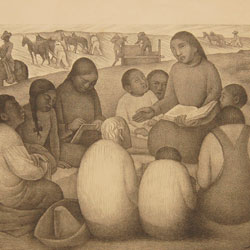
Diego Rivera, "Escuela
al Aire Libre: Maestra Rural" [Open Air School: Rural Teacher], Lithograph.
1932. Edition of 100. [314 x 416 mm].
|
Final Assignment: Your final assignment
in the course will be a major (15-20 page) research project on any aspect of
the Mexican Revolution that we have covered in the course. We will discuss the
final assignment more in class, but it will need to be essentially about Mexico
during or after the Revolution, rather than a topic on the Mexican community
in the United States, for example. All projects are due no later than
11:00 AM on Saturday, December 20. Projects turned in after that time which
do not have an official incomplete in the course will not be read and will receive
an "F".
Plagiarism and the Honor Code: "The
word plagiarism derives from Latin roots: plagiarius, an abductor, and
plagiare, to steal. The expropriation of another author’s work,
and the presentation of it as one’s own, constitutes plagiarism and is
a serious violation of the ethics of scholarship." [American
Historical Association, Statement on Standards of Professional Conduct].
As much as I would like to say that plagiarism doesn't occur at Oberlin, I encounter
at least one, if not more, serious incident each semester. It is always very
straight forward: students copy sections of other texts and attempt to pass
them off as their own work. Copying the work of others goes against everything
that a liberal education is about. It is a serious affront to the other students
in the course, to me as instructor, and to the plagiarizer him/herself. For
further information on plagiarism at Oberlin, see the student Honor
Code, pg. 1. If you have questions about what constitutes plagiarism, particularly
in the context of joint or collaborative projects, please see me or raise it
in class.
Grading:
- Discussion preparation and leadership: 25%
total (12.5% each)
- Work around the AMAM exhibit: 25%
- Final assignment: 35%
- Class participation: 15%
Students with Disabilities:
Appropriate accommodations will always be granted
to students with documented disabilities. Any questions about the necessary
process of documenting disabilities should be addressed to Jane Boomer, Coordinator
of Services for Students with Disabilities (Peters G27-28; x5-5588).
Language:
Many of the readings are available in Spanish.
If you would prefer to read in Spanish, that would be fine. Please see me if
you want help locating a Spanish edition of the work.
Books Recommended for Purchase:
All required readings
are available in the Reserve Room of Mudd. Some (see the syllabus) are available
in electronic copies posted on the course site in Blackboard. Additional copies
of the books in the course can be obtained through OHIOLink -- just make sure
you request them with enough lead time. The following books have been ordered
for the bookstore and can be purchased there as well as at on-line booksellers.
Vendors such as Amazon or presses such as Seven Stories (both linked here) often
offer used or less expensive new versions.
|
Mariano Azuela, The
Underdogs: A Novel of the Mexican Revolution, trans. Sergio Weisman,
intro, Carlos Fuentes (NY: Penguin), 2008.
Anita Brenner and George R. Leighton, The
Wind that Swept Mexico: The History of the Mexican Revolution of 1910-1942
(Austin: University of Texas Press), 1984.
David Craven, Art
and Revolution in Latin America, 2nd ed. (New Haven: Yale University
Press), 2006.
Carlos Fuentes, The
Death of Artemio Cruz, rev. ed. (NY: Farrar, Strauss, and Giroux),
1991.
Alicia Hernández
Chávez, Mexico:
A Brief History (Berkeley and Los Angeles: University of California
Press), Andy Klatt, trans., 2006.
Octavio Paz, The
Labyrinth of Solitude: The Other Mexico, Return to the Labyrinth of Solitude,
Mexico and the United States, the Philanthropic Ogre (NY: Grove
Press), Lysander Kemp, Yara Milos and Rachel Phillips Belash, trans.,
1994.
John Reed,
Insurgent Mexico (NY: International Publishers), 1988.
Paco Ignacio Taibo II, '68
(NY: Seven Stories Press), Donald Nicholson-Smith, trans., 2004.
John Womack, Zapata
and the Mexican Revolution (NY: Vintage), 1970.
|
|
Syllabus
September 2: Introduction - Revolution,
Nation, and History
Reading:
Thomas Benjamin, "Introduction: The Revolution
with a Capital Letter," in La Revolución: Mexico's Great Revolution
as Memory, Myth and History (Austin: University of Texas Press, 2000),
pp. 13-23. [Blackboard and Regular Reserve]
September 9 - Some Background
Reading:
Alicia Hernández Chávez,
Mexico: A Brief History (Berkeley and Los Angeles: University of California
Press, 2006), Chapter 8 to end (pp. 170-357).
Chronologies, from Benjamin, La Revolución (pp. 25-29; 79-83).
[Blackboard and Regular Reserve]
September 16 - Like a Leaf in
the Wind
Reading:
Mariano Azuela, The Underdogs: A Novel of
the Mexican Revolution, trans. Sergio Weisman, intro, Carlos Fuentes (NY:
Penguin), 2008 [1915]
| September 21: NOTE: Field trip to
Detroit Institute of the arts to view the "Detroit Industry" murals
by Diego Rivera put off until after Fall Break. Check later for more information. |
September 23 - The Revolutionary
as Hero
|
|
Reading:
John Reed, Insurgent Mexico (NY:
International Publishers), 1988 [1914]
Pancho Villa; photographer unknown
|
| September 30: First draft of extended
labels and script for longer document on art work due today. |
September 30 - Art, Artists, and the Revolution
[NOTE: Class will begin at 7:30]
Reading:
David Craven, Art and Revolution in Latin
America, 2nd ed. (New Haven: Yale University Press, 2006), 1-73.
Sunday, October 5 (NOON at Mr.
Volk's house) - The Revolution Will Be Photographed
Reading:
Anita Brenner and George R. Leighton,
The Wind that Swept Mexico: The History of the Mexican Revolution
of 1910-1942 (Austin: University of Texas Press), 1984 [1943].
|
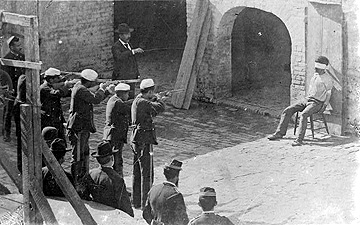
(Robert
Runyon, Execution of Antonio Echazaretta by firing squad, Library of
Congress, Robert Runyon Photograph Collection, glass plate negative,
Digital ID: txuruny 00262
|
| October 7: Second draft of extended labels
and script for longer document on art work due today. There is no class
today -- it was moved to October 5. Drafts of both materials will be due
by 9:00 PM via email. |
October 12: Screening of "Vamonos con
Pancho Villa" - 8:30 PM (Mudd 052). Popcorn WILL be provided!
| October 17: Third draft of extended labels
for your art pieces is due today. |
October 14 - The Revolutionary
as Villain: The Fernando de Fuentes' Trilogy [we will screen "Vamonos con
Pancho Villa" [1936] at another time]
Reading:
Andrea Noble, "The Mexican Revolution
as Moving Memory," in Mexican National Cinema (London and NY:
Routledge, 2006), 48-69. [Blackboard and Regular Reserve]
| October 28: Final script for podcast
is due today. Information on how to upload your sound files can be found
on Blackboard under "Assignments" |
October 28: The Mexican as Chingado
Reading:
Octavio Paz, The Labyrinth of Solitude:
The Other Mexico, Return to the Labyrinth of Solitude, Mexico and the United
States, the Philanthropic Ogre (NY: Grove Press, 1994) [1950]. Read "The
Labyrinth of Solitude" only (pp. 5-212).
| November 4 - Initial topic for final
research paper (one paragraph including the topic and why you want to work
on it) at start of class. |
November 4 - The Frozen Revolution
Reading:
Carlos Fuentes, The Death of Artemio
Cruz, rev. ed. (NY: Farrar, Strauss, and Giroux, 1991) [1960].
|
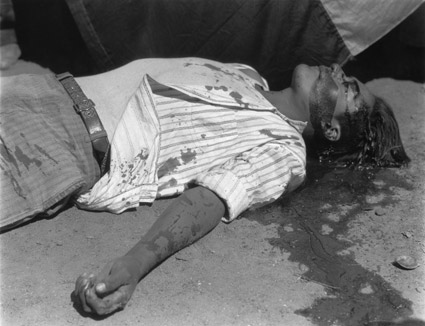
Manuel Alvarez Bravo, "Obrero en huelga
asesinado" [Striking worker murdered], 1934 [19.1 x 24.6]
|
November 11 - The Revolutionary
as Contemporary Radical
Reading:
John Womack, Zapata and the Mexican Revolution
(NY: Vintage, 1970) [1969].
| November 18 - Refined topic for final
research paper plus a preliminary bibliography due at start of class. |
November 18 - The Revolution
is Dead
Reading:
Paco Ignacio Taibo II, '68 (NY: Seven
Stories Press), 2004.
November 23: Screening of "Amores
Perros" - 8:30 PM (Mudd 052)
November 25 - There Was No Revolution:
"Amores Perros" (Alejandro González Iñárritu,
dir - 2000)
Reading:
Carlos Monsiváis, "Mexico 1890-1976:
High Contrast, Still Life," Mexican Postcards, John Kraniauskas,
ed. and trans. (London: Verso, 1997), pp. 1-30.

(Subcomandante Marcos and the
EZLN, Chiapas)
| December 2 - Fully developed thesis statement
for project plus developed bibliography due at start of class. |
December 2 - The Revolution Reborn
Reading:
Selections from: Juana Ponce de Leon, ed.,
Our Word Is Our Weapon: Selected Writings from Subcomandante Marcos
(New York: Seven Stories Press, 2001), pp. 13-59, 96-105, 151-154.
December 9 - Conclusion -
The Revolution is Dead. "¡Viva la Revolución!"
Reading:
Vicente T. Gawronski, "The Revolution
is Dead. '¡Viva la revolución!': The Place of the Mexican Revolution
in the Era of Globalization," Mexican Studies/Estudios Mexicanos
18:2 (Summer 2002): 363-397.
| December
20, 11:00 AM - Final Assignment Due. Your final assignment, a 15-20 page
research paper on any aspect of the Mexican Revolution, will be due no later
than 11:00 AM on Saturday, October 20. Any paper turned in after that time,
unless you have applied for an official incomplete in the course, will not
be read. |


